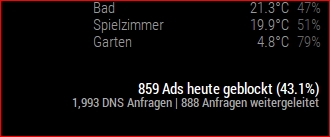yes its named “compliments”, already build in and shows for instance
“you look amazing!”
:)
yes its named “compliments”, already build in and shows for instance
“you look amazing!”
:)
please do not use this thread for a complete other module and problem
maybe this is what you are looking for?
https://forum.magicmirror.builders/topic/1467/mmm-plexnowplaying-display-current-song-played-by-plexmediaserver
?
Habe you compared the Laptops Power consumption with the raspberries? ;)
For sure it runs way better, but if you use just normal stuff, it is absolute not necessary imho.
Most of us use the mirror on the wall, without tons of cables (execpt Power) viewable. With a Laptop you have to be more tricky.
But nice to know that it runs easily With Ubuntu :D
I want to push this again, since i recognize there is a lot ongoing currently in the forums.
My updated list
What are your current top3 ?
Looks nice.
Playing some real classics :)
Still searching for a solution for a logitech Media Server. Hopefully your Code can point me to the right direction. Guess the api could be similar. Hopefully
oh i forgot something…
i also added this one at the pi server
In file /var/www/html/admin/scripts/pi-hole/php/auth.php add your host in the array of allow hosts:
$AUTHORIZED_HOSTNAMES = array( $ipv4, $ipv6, str_replace(array("[","]"), array("",""), $_SERVER["SERVER_NAME"]), "pi.hole", "localhost", "your.hostname.com" );
got it work.
Check if your clone from git is correct from up an lowercase…
for me it was cloned to
mmm-pihole-stats
instead of
MMM-pihole-stats
also check that in the config style.
it only showed something for me, after setting
showSources: false,
Maybe it helps someone
changed also some stats to see the more interesting stuff

19€ for the mirror?
That is really cheap
looks fine.
From the official Raspberry site:
Video mode
Custom mode
If your monitor requires a mode that is not in one of the tables above, then it's possible to define a custom CVT mode for it instead:
***please note, need to ad a blank space before the bracket, in order to display it here correctly***
hdmi_cvt=< width> < height> < framerate> < aspect> < margins> < interlace> < rb>
Value Default Description
width (required) width in pixels
height (required) height in pixels
framerate (required) framerate in Hz
aspect 3 aspect ratio 1=4:3, 2=14:9, 3=16:9, 4=5:4, 5=16:10, 6=15:9
margins 0 0=margins disabled, 1=margins enabled
interlace 0 0=progressive, 1=interlaced
rb 0 0=normal, 1=reduced blanking
Fields at the end can be omitted to use the default values.
Note that this simply creates the mode (group 2 mode 87). In order to make the Pi use this by default, you must add some additional settings. For example, the following selects an 800 × 480 resolution and enables audio drive:
hdmi_cvt=800 480 60 6
hdmi_group=2
hdmi_mode=87
hdmi_drive=2
This may not work if your monitor does not support standard CVT timings.